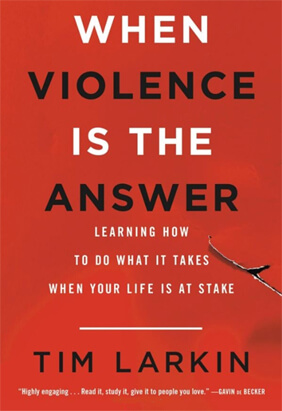- timlarkin
The Beating, the Breaking, or the Fall from a Great Height?
The intelligent use of violence involves every means available — all bets are off and no holds barred. You literally do whatever you want to the man (this is, after all, what we mean by ‘free’ in ‘free fighting’). We have the ages-old rock to the head; we can break his joints by putting the torque in Torquemada; we can use the happy constancy of gravity and other assorted physical laws to line up the ultimate rock to the head, by throwing him into the regolithic embrace of Mother Earth.
But which one is better? Which one is a more intelligent use? Is there veracity to the implied hierarchy of striking, joint breaking and throwing?
The answer to all of those questions lies in the definition of injury in violence: body weight in motion applied through a target. We all know that injury is the only thing that means anything in violence, it is where violence begins and simultaneously ends, it is the ultimate goal. We also know that striking, joint breaking and throwing all result in injury when done correctly. What most people don’t realize is that these three seemingly disparate ‘techniques’ for causing injury are really all one in the same — they are three different expressions of the same idea.
Striking is easy enough for people to grok; body weight in motion through a target, the rock to the head. Or, to ‘fancify’ it, the fist through the ribs, the stomp to the throat. Every human being has an innate understanding of this, whether they know it or not. Add a stick or a knife to the outer end of this and we have what looks like choreography for the six o’clock news. Everybody, everywhere, is doing it!
Joint breaking is where almost everyone gets left behind. It puts the ‘fancy’ in ‘fancy pants.’ Now you must possess the wileyness of the monkey, the speed of the cheetah and the suppleness of the cockroach, right? Probably not, given that an excellent joint break can occur ‘accidentally’ in an American football game from nothing more advanced than one guy falling on another.
Throwing is even more ‘advanced’ than joint breaking, right? I mean, it’s last on the list, and who really has the inhuman strength to pick up and hurl a 300 pound screaming man to the deck? Well, very few people, if you put it in those terms. If we change those terms, say to defining a throw as an uncontrolled fall into the ground (uncontrolled for him, not you), then literally anyone can do it. If a two-year-old can trip a grown man such that he ends up with a broken wrist, then so can you.
All three of these are still body weight in motion applied through a target. Striking is obvious because the body weight is yours and the target is something obvious, like a knee or a groin. Joint breaking is still body weight in motion through a target, only now the target is a joint that is stressed at its pathological limit, i.e., ‘ready to blow.’ Throwing is the only truly deceptive one — you will typically use your body weight in motion to get him off balance and falling, using his body weight in motion applied through a target (him falling on his head) with the striking surface being the planet rather than one of your body parts.
Let’s take a look at a truly simple application of all of these ideas simultaneously: you’ve injured him, he’s down on one knee, his back to you, slightly off to your right. You have his left wrist held fast in both of your hands, his arm straight out from his body (parallel to the ground). What happens if you lunge through his arm, striking the back of his extended elbow with your hip, and then rotate 180˚ to your left (a lunge with a full pivot into the other forward stance). Well, let’s see: his elbow will break and he’ll be hurled to the ground by the drive and full rotation.
Is it a strike, a joint break, or a throw?
Rhetorical, I know, because you already have the answer — it’s all three at once. Body weight in motion applied through a target results, in this case, a strike that breaks the elbow and powers a throw.
So which one is superior? Does this mean that striking ‘comes first?’
Hardly. What it means is that joint breaking and throwing are just special cases of striking — striking can’t come before either because they are themselves strikes.
There is no hierarchy. There is only ever body weight in motion applied through a target. It’s how you mix up those two elements that decides whether it ends up being a vanilla strike, or a broken joint, or a hard fall.
And injury being injury, they are all equal in the eyes of the ER radiologist — and so they should be to you.
All Latest Posts
- WHATS MISSING IN ALL SELF PROTECTION TRAINING & WHY THE MEDIA LIKES IT THAT WAY
- SELF-DEFENSE AND FIGHT SCIENCE
- PREVENT VIOLENCE VS. DO VIOLENCE: PART I
- PREVENT VIOLENCE VS. DO VIOLENCE: PART II
- SELF DEFENSE TRAINING: KILLING WITH RULES
- SELF-DEFENSE: STOP FIGHTING AND DELIVER A BEATING
- SELF PROTECTION QUESTION: HOW CAN I JUSTIFY THE USE OF VIOLENCE?
- SELF-PROTECTION MENTALITY: I WAS PREOCCUPIED WITH WHAT I WAS GOING TO DO TO HIM
- FIRST STRIKE: HOW AND WHY YOU SHOULD LAND IT
- INTIMIDATION DURING SELF PROTECTION IS A SUCKER’S GAME
- ANTISOCIAL CONFRONTATION: AGGRESSIVE, BADASS OR DEADLY?
- DEBILITATING INJURY: HOW TO TAKE A PUNCH
- TARGET FOCUS TRAINING PRINCIPLES IN A NUTSHELL
- SELF PROTECTION LESSON: MOVE WITH THE INJURED MAN
- SELF-DEFENSE CLASSES: WHO HAS THE REAL KOOL-AID?
- THE “NUCLEAR OPTION” OF LIFE OR DEATH SELF-DEFENSE
- INJURY IS THE ONLY GOAL OF VIOLENCE
- WHEN IS IT TIME TO LEARN SELF-DEFENSE TECHNIQUE?
- La guía de autodefensa de un teleadicto y otras historias
- Ein Couch-Potato-Leitfaden zur Selbstverteidigung und andere Geschichten
- SELF DEFENSE FACT: FIGHTING IS HARD. HURTING PEOPLE IS EASY.
- THE OL’ ONE-TWO
- ANTI-SOCIAL AGGRESSION AND TRAGEDY ARE AVOIDABLE
- PERSONAL SELF-DEFENSE: THERE ARE NO “EASY” TARGETS
- SELF-DEFENSE LESSONS: YOU CAN’T WAVE AN INVISIBLE GUN
- ARE YOU AGGRESSIVE, BADASS, OR DEADLY?
- THE TARGET FOCUS TRAINING EXPERIENCE
- SELF-DEFENSE Q&A: WHERE DOES TFT FIT INTO LAW ENFORCEMENT?
- IS LETHAL FORCE SELF-DEFENSE USEFUL IN YOUR EVERYDAY LIFE?
- “But I Don’t Want to Kill Anyone!”
- “But What If He Flinches?”
- A Couch Potato’s Guide To Self Defense and Other Stories
- Why Not Just Buy a Gun?
- It’s a Nice Idea–But Does It Really Work?
- There’s only one way to train
- The Beating, the Breaking, or the Fall from a Great Height?
- Speed: The Last Thing You Need For Self-Defense
- Fighting Through Injury
- Targeting: Secret To Self Defense Success?
- Are You Learning To Fight… Or To Dance?
- Generación de máxima potencia
- Maximale Leistung erzeugen
- What Color Crayon Should I Use For A Ruptured Spleen?
- INJURY – The Only Goal Of Violence
- Violence as a Survival Tool
- Generating Maximum Power
- Social Confrontation vs Asocial Violence – Part 3
- Social Confrontation vs Asocial Violence – Part 2
- Social Confrontation vs Asocial Violence – Part 1
- Striking… TFT Style
- The Final Word in Context: MURDER
- Scenario Based Training Vs. The Hard Knot
- Time to Stop Lying to Yourself
- The Mindset to Survive and the Will to Win
- Training to “Wait and See”
- Access the Meat: Choosing the Level of Interaction in Violent Conflict
- Why Self-Defense is NOT Enough…
- SOCIAL OR ASOCIAL VIOLENCE – WHY BOTHER?
- THE ULTIMATE SELF-DEFENSE FIGHTING TECHNIQUE
- STRIKING – TFT STYLE
- ACCESS THE MEAT: CHOOSING THE LEVEL OF INTERACTION IN VIOLENT CONFLICT
- SELF DEFENSE IS NOT ENOUGH
- LEARN SELF DEFENSE: SHUT UP AND HURT HIM
- WINNING VIOLENCE: WOULD IT MATTER TO A SERIAL KILLER?
- DO SELF DEFENSE LESSONS LIKE TFT REALLY WORK?
- SELF-DEFENSE FACT: INJURY IS WHAT WORKS IN VIOLENCE
- SELF-DEFENSE TRUTH: WORRYING ABOUT LOSING WON’T MAKE YOU WIN
- LEARNING SELF-DEFENSE IS NOT ENOUGH
- PROTECT YOURSELF: BUILD A BETTER MONSTER
- LEARN SELF DEFENSE: THE DEFINITION OF VIOLENCE
- SELF DEFENSE QUESTION: ARE THERE ANY DOWNSIDES TO LIVING IN THE CAUSE STATE?
- A SELF DEFENSE TOOL IS JUST A TOOL
- SURVIVING THE AFTERMATH OF SELF-DEFENSE
- MULTIPLE ATTACKERS SELF-DEFENSE: PART THREE
- SELF PROTECTION: NATURE OR NURTURE?
- SELF DEFENSE AND YOUR EXPECTATIONS
- UNDERSTANDING VIOLENCE: FOUR LEVELS OF HUMAN INTERACTION
- WHY DO WE TEACH LETHAL SELF DEFENSE?
- SELF DEFENSE MINDSET: WHAT IS YOUR LIFE WORTH?
- BUT I DON’T WANT TO KILL ANYONE!
- SELF DEFENSE TRAINING VS. MMA TRAINING
- MULTIPLE ATTACKERS SELF DEFENSE: PART TWO
- ES IST EINE MÄNNER WELT… ODER WARUM ICH ES HASSE, FRAUEN ZU TRAINIEREN
- IMPACTANTE ESTUDIO REVELA QUE LA CONDICIÓN FÍSICA NO ES UN FACTOR CUANDO LUCHA POR SU VIDA
- CUANDO TU VIDA ESTÁ EN JUEGO, AQUÍ ES CÓMO JUGAR SEGÚN LAS REGLAS
- SCHOCKIERENDE STUDIE ZEIGT, DASS FITNESS KEIN FAKTOR IST, WENN UM IHR LEBEN KÄMPFT
- WENN IHR LEBEN AUF DEM SPIEL STEHT, SO SPIELEN SIE NACH DEN REGELN
- MANIOBRAS CORPORAL PARA EMPRESARIOS
- KÖRPERMANÖVER FÜR GESCHÄFTSLEUTE
- ES UN MUNDO DE HOMBRES… O POR QUÉ ODIO ENTRENAR MUJERES
- USING VIOLENCE: DEAD MEN TELL NO TALES
- MULTIPLE ATTACKERS SELF DEFENSE: PART ONE
- SLOW YOUR SELF PROTECTION TRAINING DOWN
- SELF DEFENSE TECHNIQUE: BUILD YOUR TARGET MAP
- SELF DEFENSE MOVES: KNOW HOW TO BREAK A NECK
- VIOLENCE & KISS (OR KILL IT SIMPLY, STUPID)
- SELF DEFENSE IS A SHAM • PART 2
- PRACTICING SELF DEFENSE: CAN BIGGER-STRONGER-FASTER MAKE A DIFFERENCE?
- THE BLUEPRINT FOR SUCCESS IN USING VIOLENCE
- SELF DEFENSE IS A SHAM • PART 1
- VIOLENCE STARTS AND ENDS WITH YOU
- FORGET FIGHTING. DELIVER AN INJURY.
- A FIREARM ISN’T EVERYTHING
- NAILING DOWN INTENT
- THE ANATOMY OF A SELF DEFENSE SEMINAR
- THE SELF DEFENSE PARADOX: IF YOU WANT A TRULY PEACEFUL LIFE, THEN TRAIN VIOLENCE.
- WHEN YOUR LIFE IS ON THE LINE, HERE’S HOW YOU PLAY BY THE RULES
- SHOCKING STUDY REVEALS FITNESS NOT A FACTOR WHEN FIGHTING FOR YOUR LIFE
- BODY MANEUVERS FOR BUSINESSMEN
- ITS A MAN’S WORLD… OR WHY I HATE TRAINING WOMEN









